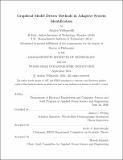| dc.contributor.advisor | James C. Preisig. | en_US |
| dc.contributor.author | Yellepeddi, Atulya | en_US |
| dc.contributor.other | Woods Hole Oceanographic Institution. | en_US |
| dc.date.accessioned | 2017-03-20T19:08:34Z | |
| dc.date.available | 2017-03-20T19:08:34Z | |
| dc.date.copyright | 2016 | en_US |
| dc.date.issued | 2016 | en_US |
| dc.identifier.uri | http://hdl.handle.net/1721.1/107499 | |
| dc.description | Thesis: Ph. D., Joint Program in Applied Ocean Science and Engineering (Massachusetts Institute of Technology, Dept. of Electrical Engineering and Computer Science; and the Woods Hole Oceanographic Institution), 2016. | en_US |
| dc.description | This electronic version was submitted by the student author. The certified thesis is available in the Institute Archives and Special Collections. | en_US |
| dc.description | Cataloged from student-submitted PDF version of thesis. | en_US |
| dc.description | Includes bibliographical references (pages 209-225). | en_US |
| dc.description.abstract | Identifying and tracking an unknown linear system from observations of its inputs and outputs is a problem at the heart of many different applications. Due to the complexity and rapid variability of modern systems, there is extensive interest in solving the problem with as little data and computation as possible. This thesis introduces the novel approach of reducing problem dimension by exploiting statistical structure on the input. By modeling the input to the system of interest as a graph-structured random process, it is shown that a large parameter identification problem can be reduced into several smaller pieces, making the overall problem considerably simpler. Algorithms that can leverage this property in order to either improve the performance or reduce the computational complexity of the estimation problem are developed. The first of these, termed the graphical expectation-maximization least squares (GEM-LS) algorithm, can utilize the reduced dimensional problems induced by the structure to improve the accuracy of the system identification problem in the low sample regime over conventional methods for linear learning with limited data, including regularized least squares methods. Next, a relaxation of the GEM-LS algorithm termed the relaxed approximate graph structured least squares (RAGS-LS) algorithm is obtained that exploits structure to perform highly efficient estimation. The RAGS-LS algorithm is then recast into a recursive framework termed the relaxed approximate graph structured recursive least squares (RAGS-RLS) algorithm, which can be used to track time-varying linear systems with low complexity while achieving tracking performance comparable to much more computationally intensive methods. The performance of the algorithms developed in the thesis in applications such as channel identification, echo cancellation and adaptive equalization demonstrate that the gains admitted by the graph framework are realizable in practice. The methods have wide applicability, and in particular show promise as the estimation and adaptation algorithms for a new breed of fast, accurate underwater acoustic modems. The contributions of the thesis illustrate the power of graphical model structure in simplifying difficult learning problems, even when the target system is not directly structured. | en_US |
| dc.description.statementofresponsibility | by Atulya Yellepeddi. | en_US |
| dc.format.extent | 225 pages | en_US |
| dc.language.iso | eng | en_US |
| dc.publisher | Massachusetts Institute of Technology | en_US |
| dc.rights | MIT theses are protected by copyright. They may be viewed, downloaded, or printed from this source but further reproduction or distribution in any format is prohibited without written permission. | en_US |
| dc.rights.uri | http://dspace.mit.edu/handle/1721.1/7582 | en_US |
| dc.subject | Joint Program in Applied Ocean Science and Engineering. | en_US |
| dc.subject | Electrical Engineering and Computer Science. | en_US |
| dc.subject | Woods Hole Oceanographic Institution. | en_US |
| dc.subject.lcsh | Algorithms | en_US |
| dc.subject.lcsh | Graphical modeling (Statistics) | en_US |
| dc.title | Graphical model driven methods in adaptive system identification | en_US |
| dc.type | Thesis | en_US |
| dc.description.degree | Ph. D. | en_US |
| dc.contributor.department | Joint Program in Applied Ocean Physics and Engineering | en_US |
| dc.contributor.department | Woods Hole Oceanographic Institution | en_US |
| dc.contributor.department | Massachusetts Institute of Technology. Department of Electrical Engineering and Computer Science | |
| dc.identifier.oclc | 974643335 | en_US |
